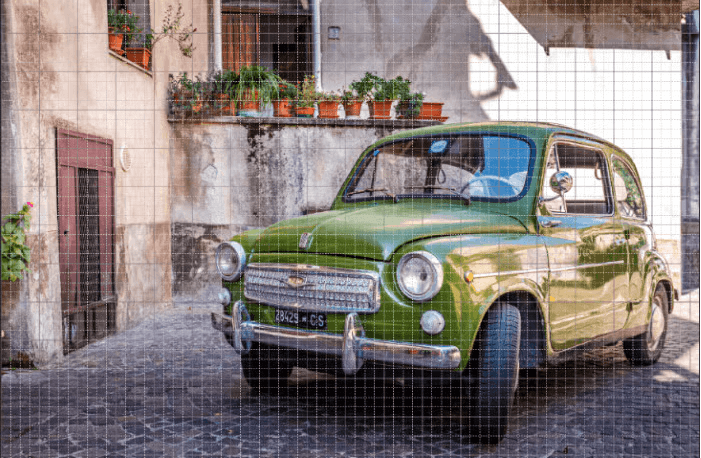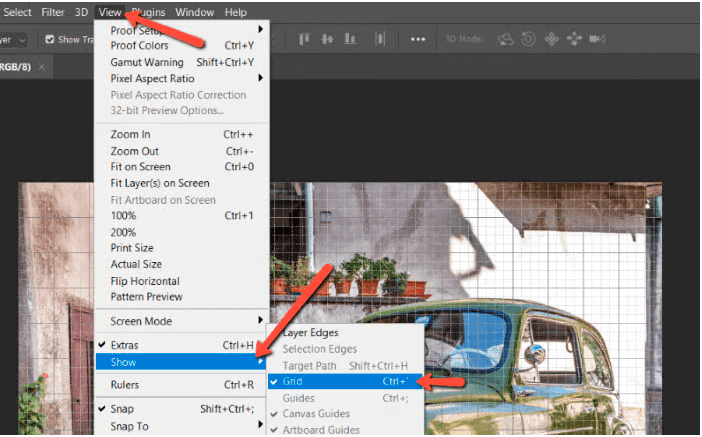If you've ever zoomed in so far on an image in Photoshop, then you've probably seen some box-like random pixel grids added to Photoshop images by default.
As a professional photographer, there are countless instances where I've zoomed in on photos up to 1200% to test accuracy.
A pixel appears whenever you zoom in largely, which can help or distract depending on the task you're working on. Thus, it's essential to know how to remove grid in Photoshop.
Turning the Pixel Grid On/Off
Don't get what I'm talking about? Here's an example of a picture I took in Prague, Czech.

When can the Pixel Grid be a problem?
The pixel grids are useful in specific scenarios. For instance, when you want to align a particular thing or want to see each pixel.
However, in most cases, pixel grids can be distracting. The white pixel lines can affect the color's visibility and make them appear lighter because of the added white.
Turning off the pixel grid is a simple fix to this issue. You can also turn on the pixel grid when you need to. And turn it off when it's distracting.
Why you Should Consider Turning off the Grid in Photoshop
One such subtlety that can significantly impact the design process is the grid. While grids provide structure and alignment, there are instances where the removal of this seemingly omnipresent guide becomes imperative for certain projects.
Distraction-Free Designing
Although a grid is a valuable aid, it can sometimes disrupt the creative process.
Removing it temporarily allows you to focus on critical areas of the project, encouraging an environment where creativity flow is unhindered.
This is more important during the conceptualization stage, enabling you to envision your work without restriction from the grid.
Precision during photo editing
Grids can disrupt the adjustment prowess during certain photo editing processes like retouching or object removal.
Removing the grid provides a clean canvas, allowing designers to zoom in and meticulously fine-tune details without the visual interference of the gridlines.
Freedom to create desired artistic expression
Structured alignment doesn't work for certain creative endeavors.
Digital paintings, abstract design, or experimental compositions thrives on Photoshop platforms that are not under the confines of grid lines. Turning off grids allows for a more fluid approach to creativity.
Strategic Alignment with Guides
Although grids are a powerful alignment tool, they're not the most versatile.
When you have projects where precise alignment is non-negotiable, utilizing guides provides a more strategic approach.
Switching grids for guides creates customized alignment, ensuring the proper placement of elements according to the project's requirements.
Optimizing Exported Files
Although grids are crucial elements during design stages, their presence in the final product may not be enticing.
That's why removing the grid before exporting files is essential, ensuring that only the polished version of the design is visible. This is especially important for portfolio pieces, client showcases, and presentations.
Encourages professionalism
In the professional design world, attention to detail is a no-brainer.
A final design product with visible gridlines may create an unprofessional impression of your design. Removing the grid before sharing or submitting work demonstrates a commitment to quality and a keen eye for presentation.
How to Turn on/Off-grid in Photoshop
Gripa helps align layers and images, and it's easy to turn on or remove.
Click on Ctrl + '(apostrophe) or Command +'. You'll immediately see the grids appear.
With spaces merged, there's virtually a line available tight where you want it to be.


That's all; it's super easy to turn on/turn off these two grid types.
Keep in mind
If you don't have prior knowledge of the Photoshop grid feature or don't know how to use the grid tool, we suggest learning how to use these tools before removing grids in Photoshop.
Doing this can disrupt your goal of a top-quality result, including distorted images or difficulty aligning.
Seamlessly Remove Grids and unwanted backgrounds With Imagewith.ai Clearoff
If you're tired of disrupting the visual appeal of your adorable photos, artwork or designs due to the presence of grids, watermarks, etc, Clearoff from Imagewith.ai can help.
Clearoff revolutionizes how you unleash the potential of your image production.
The platform inculcates a cutting edge artificial intelligence that eliminates grids, watermarks, guides, rulers, etc, from your images and maintains its quality.
Unlike using traditional tools like Photoshop, Imagewith.ai Clearoff seamlessly removes these unwanted elements while maintaining the integrity and pristine beauty of your images, only with just a few clicks.
FAQ
How do I temporarily hide the grid in Photoshop?
To temporarily hide the grid in Photoshop, you can use the shortcut "Ctrl +'" (Windows) or "Command +'" (Mac). This allows you to toggle the visibility of the grid and work in a distraction-free mode.
Can I customize the grid settings in Photoshop?
Yes, you can customize the grid settings to suit your project. Navigate to Photoshop preferences, select "Guides, Grid & Slices," and adjust parameters such as grid spacing and color according to your preferences.
Is there a way to remove the grid only for specific layers?
Unfortunately, Photoshop does not provide a direct option to hide the grid for specific layers. The grid is a global setting that affects the entire canvas. However, you can utilize other alignment tools, like guides, for layer-specific precision.
Why is it important to remove the grid before exporting files?
Removing the grid before exporting files is crucial for presenting a final product. Though helpful during the design phase, the gridlines may distract from the actual content in the exported images. Ensure the grid is hidden to maintain a professional appearance in your exported files.
What should I do if the grid persists despite turning it off in settings?
If the grid continues to appear despite turning it off in settings, consider checking if it's enabled in specific layers or groups. In addition, you may want to reset your Photoshop preferences by holding down "Alt + Ctrl + Shift" (Windows) or "Option + Command + Shift" (Mac) during application startup. This often resolves persistent grid display issues.
Final Thought
Although Grid lines are incredible features as they help us align and edit images in Photoshop, they can be distracting.
Once you've edited an image with a grid, you probably want to eliminate them on your screen.
Mastering how to remove grid in Photoshop is a subtle yet critical aspect of digital design.
You can quickly eliminate unwanted backgrounds with the Clearoff feature in Imagewith.
Say goodbye to distractions like Grids and welcome incredibly edited images with clearoff's excellent AI algorithms that help your edited images retain the same level of quality as the original, devoid of undesirable elements.
Overall, Being able to toggle grid visibility, customize settings, and know when and how to remove the grid allows you to harness the full potential of this versatile tool and keeps your creativity at bay.






